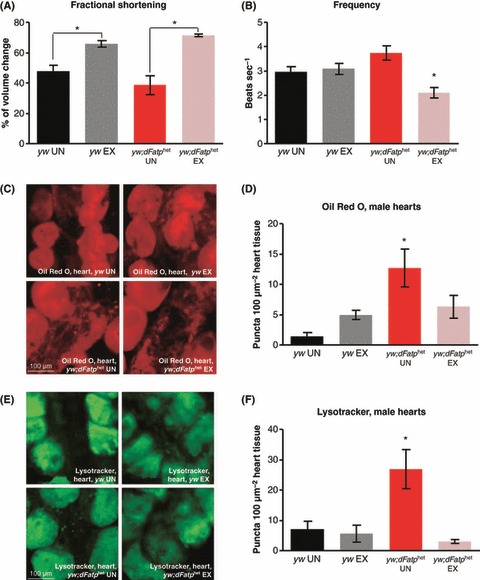Fig. 6.

Endurance Exercise rescues cardiac phenotypes of flies with reduced dFatp. (A) Both exercise-trained control flies and exercise-trained yw;dFatphet flies display increased fractional shortening compared to unexercised siblings at 3 weeks of age (t-test: P = 0.009, control flies, P = 0.002, yw;dFatphet). (B) Control yw flies exhibit no significant change in resting heart rate following exercise training (P = 0.714). Cardiac frequency is reduced in yw;dFatphet flies following exercise training. (P = 0.049). (C) Representative 40 × micrograph of Oil Red O staining in yw and yw;dFatphet hearts with and without exercise at 3 weeks of age. (D) Quantification of Oil Red O staining shows increased lipid in 3-week-old, unexercised yw;dFatphet hearts (one-way anova: P = 0.004). Both male and female yw;dFatphet flies were found to have increased baseline Oil Red O staining when compared to background controls. Males are depicted here. Following exercise, Oil Red O staining in yw;dFatphet hearts returned to wild-type quantities (Dunnett pos t-test: P = 0.459 for exercised values when compared to unexercised control). (E) Representative 40 × micrograph of lysotracker staning in yw and yw;dFatphet hearts, with and without exercise, at 3 weeks of age. (F) Both male and female yw;dFatphet flies were found to have increased baseline lysotracker staining. Males are presented here. Quantification of lysotracker staining shows enhanced autophagy in 3-week-old, unexercised yw;dFatphet hearts (one-way anova: P = 0.0006). Following exercise, lysotracker punctae in yw;dFatphet hearts return to wild-type quantities (Dunnett pos t-test: P = 0.218 for exercised values when compared to unexercised control). n ≥ 10 flies for all stains.
